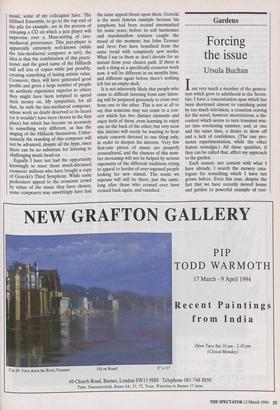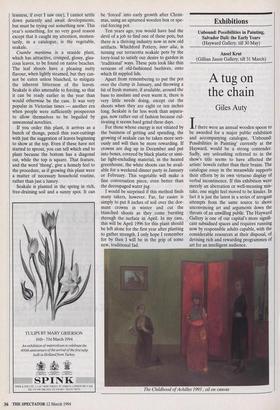Gardens
Forcing the issue
Ursula Buchan
Iam very much a member of the genera- tion which grew to adulthood in the Seven- ties. I have a concentration span which has been shortened almost to vanishing point by too much television; a ceaseless craving for the novel, however meretricious; a dis- content which seems to turn transient win- ter into everlasting summer, and, at one and the same time, a desire to show off and a lack of confidence. (The one pro- motes experimentation, while the other fosters nostalgia.) All these qualities, if they can be called that, affect my approach to the garden.
Each season, not content with what I have already, I search the nursery cata- logues for something which I have not grown before. Even this year, despite the fact that we have recently moved house and garden (a powerful example of rest- lessness, if ever I saw one), I cannot settle down patiently and await developments, but must be trying out something new. This year's something, for no very good reason except that it caught my attention, momen- tarily, in a catalogue, is the vegetable, seakale.
Crambe maritima is a seaside plant, which has attractive, crimped, glossy, glau- cous leaves, to be found on native beaches. The leaf shoots have a pleasing nutty flavour, when lightly steamed, but they can- not be eaten unless blanched, to mitigate the inherent bitterness of the leaves. Seakale is also amenable to forcing, so that it can be ready earlier in the year than would otherwise be the case. It was very popular in Victorian times — another era when people were sufficiently prosperous to allow themselves to be beguiled by unseasonal novelties.
If you order this plant, it arrives as a bunch of thongs, pencil thin root-cuttings with just the suggestion of leaves beginning to show at the top. Even if these have not started to sprout, you can tell which end to plant because the bottom has a diagonal cut, while the top is square. That feature, and the word 'thong', give a homely feel to the procedure, as if growing this plant were a matter of necessary household routine, rather than just a luxury.
Seakale is planted in the spring in rich, free-draining soil and a sunny spot. It can be 'forced' into early growth after Christ- mas, using an upturned wooden box or spe- cial forcing pot.
Ten years ago, you would have had the devil of a job to find one of these pots, but there is a thriving industry now in new old artifacts. Whichford Pottery, inter alia, is turning out terracotta seakale pots by the lorry-load to satisfy our desire to garden in `traditional' ways. These pots look like thin versions of old-fashioned beehives, onto which fit nippled lids.
Apart from remembering to put the pot over the clump in January, and throwing a bit of fresh manure, if available, around the base to insulate and even warm it, there is very little needs doing, except cut the shoots when they are eight or ten inches long. Seakale is far less work than aspara- gus, now rather out of fashion because cul- tivating it seems hard grind these days.
For those whose energy is not vitiated by the business of getting and spending, the growing of seakale can be taken more seri- ously and will then be more rewarding. If crowns are dug up in December and put into boxes, covered by black plastic or simi- lar light-excluding material, in the heated greenhouse, the white shoots can be avail- able for a weekend dinner party in January or February. This vegetable will make a fine conversation piece, even better than the decoupaged water jug.
I would be surprised if this method finds many takers, however. Far, far easier is simply to put 8 inches of soil over the dor- mant crowns in winter and cut the blanched shoots as they come bursting through the surface in April. In my case, this will be April 1996 for this plant should be left alone for the first year after planting to gather strength. I only hope I remember for by then I will be in the grip of some new, traditional fad.



















































 Previous page
Previous page